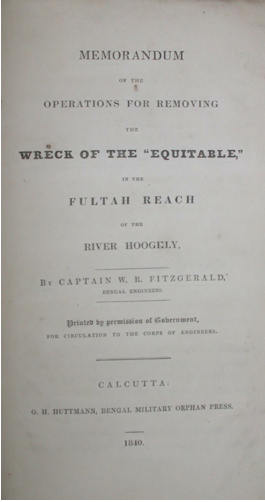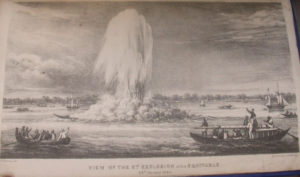My last post about the evolution of detonators involved digging around in some interesting history. I came across two fascinating reports about a British military engineering operation on the Hoogly River in Bengal in 1839 and 1840. The crucial piece about this story is that it straddled the invention of sub-aqua electrical initiation of gunpowder charges as used by Pasley with the earlier much less reliable igniferous technique, in this case using tubes of lead filled with gunpowder, soldered together. The reports are found in the professional papers of the Royal Engineers, 1840 and Volume 8 of the Journal of the Asiatic society of Bengal, 1840. Go google if you want to read the originals.

The circumstances were that a ship, the Equitable, had sunk on a sandbank and was posing a hazard to shipping. So a young British military engineer, Captain Fitzgerald serving in the Bengal Engineers and some colleagues decided to blow it up, as is the wont of young Engineer officers. In this case (and not for the last time), they were accompanied, encouraged and assisted by a young medical officer
So, this was a complex operation in a fast flowing and murky river. The Equitable had sunk in October 1839 in the middle of the shipping channel. It was decided to use large gunpowder charges to break up the vessel.
Attempt 1, Igniferous – Failed.
The first attempt used a large waterproof cylinder full of gunpowder, ignited by means of a linen hose protected by lead piping. The charge was an enormous 2400 pounds of powder. The cylinder was an oak cask, bound with iron hoops, and plates of lead were carefully soldered onto it to seal it. The lead pipe protecting the powder train in the hose was made from four 15 feet lengths, soldered carefully together. The hose, one inch in diameter and containing gunpowder was then inserted into the pipe. I have a description of the explosive chain between the main charge and the gunpowder hose, but have not yet found an associated diagram. so I can’t yet make head or tail of it. The characteristics of a loose filled gunpowder hose clearly gave rise to challenges, in terms of transmission of the igniferous process in a vertical pipe. To manage this the hose was knotted every 6 inches, and held in place by fastening to a pewter wire inserted down the length of the pipe.
The seal between the powder hose in the pipe and the “primer cylinder” appears to have been achieved with brass fittings and leather gaskets.
The first attempt took place on December 6 1839, and the charge was lowered from a boat onto the deck of the sunken ship. A “portfire” with an estimated burning time of 10 minutes fastened to the top of the gunpowder filled pipe, and the boat rowed away. However the portfire failed to ignite the gunpowder train. A second portfire was set, and after a few minutes a muffled small explosion was heard, which was assessed as being the pipe rupturing. The main charge failed to ignite, and the pewter wire was ejected from the lead pipe. The pipe was raised and the rupture found at 25 feet from the top.
Attempt 2. Timed, electrical, using a watch – Successful
For the second attempt the Egineer team, encouraged by a medical doctor William O’Shaugnessy, and no doubt hearing of the success of Pasley, used an electrical initiation method. O’Shaugnessy “read up” on electrical theory and designed and built his own galvanic battery, a description of which can be found in the reference. O’Shaugnessy conducted several experiments with his battery and platinum wire or platinum foil filaments, making the foil white heat with its electrcial resistance. Working the physics, O’Shaughnessy established that with some careful design he could initiate the platinum filaments through bare un-insulated wire, under water, provided he kept the “legs” sufficiently far apart and the battery powerful enough. He also designed a highly ingenious system for holding the filament in a sealed container using a breech of a gun. Furthermore O’Shaugnessy then designed a remarkable timing initiation using a simple watch, copper “arms” and mercury filled tubes that the copper arms of the watch swept through that automatically “made safe” the firing circuit four minutes after initiation, so it would be safe to recover if the initiation failed. It is clear from O’Shaugnessy’s report that he had no actual reports of Pasley’s successes other than newspaper reports, and so was working on first principles.
The second attempt took place on 14 December 1839, using this electrical mechanism, the battery and timer being in a small fishing boat above the charge. After setting charge, the demolition party consisting of Capts Fitzgerald and Debude, and Lieutenant Smith, accompanied by O’Shaughnessy and his assistant Mr Siddons, rowed quickly away. Here’s O’Shaugnessy’s description of the subsequent explosion:
At the thirteenth minute a slight concussion was was felt in our boat, a sound like that of a very distant and heavy gun at sea was heard, and a huge hemispherical mass of discoloured water was thrown to the height of about 30 feet. From the centre of this mass there then rose slowly a and majestically a pillar of water, intermingled with foam and fragments of wreck , and preserving a cylindrical form till it reached an elevation of at least 150 feet. The column then subsided slowly, a wreath of foam and sparking jets of water following its descent, and rendering the spectacle one of indescribable beauty.

O’Shaughnessy later also significantly improved the manner in which the heated platinum filament ignites the charge. Previously the heated filament was embedded directly into gunpowder but O’Shaughnessy found that by embedding the filament in cotton which had been soaked in a solution of “purest saltpeter” effectively lowered the temperature that the filament was required to reach to cause ignition.
Attempt 3, Electrical using an improvised timing mechanism involving portfires and “string” – Failed
A third operation occurred a month later to remove a large part of the sunken wreck still remaining, and this too used a timing mechanism and electrical initiation, however the system failed to initiate due to damage to the priming charge where it was fastened to the main charge. The sapper officers revised the mechanical timing mechanism of an adapted watch used by O’Shaughnessy and used portfires burning string at timed intervals to make and then break a circuit if detonation had not occurred – I see in the different reports of Capt Fitzgerald and Dr O’Shaughnessy a little irritation from the good doctor as to the contrived nature of this measure, which he regards as crude an unreliable, but which the sapper officers are very proud of (it saved the expense of a watch).
Attempt 4. Electrical using an improvised timing mechanism involving portfires and “string” – Successful
A fourth operation took place on 28th January 1840. A successful explosion took place, breaking up the remaining part of the wreck and also killing two porpoises.
O’Shaughnessy went on to an interesting career where he was involved in pharmacology, the electric telegraph, encryption and most famously the introduction of cannabis to the UK for “therapeutic use”.
